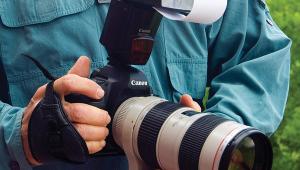Digital Image Sensor Update
![]()
A Special Report from the PMA Show
Digital Image Sensor Update
The Promise of Even Better Image Quality Ahead
by George Schaub
In light of recent developments, and with products unveiled here at PMA, it's
clear that manufacturers are aiming their efforts at bringing out cameras that
equal, and hopefully exceed the "film experience." And they are
doing so in increasingly sophisticated ways. Yes, there are product differentiators--high
zoom ratios, image stabilization, ever slimmer sizes, large LCD monitors, on-board
presentation software and clever technology that overcomes some of the past
failings and foibles of the digital camera realm. Yet, as the megapixel race
fades into marketing history, we're seeing more concentration on technology
at the sensor and processing level, the heart of matter when it comes to image
quality.
Sensor Types
While there are still kit-built digital cameras, more and more companies are
marshalling their own technological forces to develop sensors and solutions
that address the demands of digital technology. There are two main types of
sensors in digital cameras, with a third recently introduced by Olympus in their
new EVOLT 330 DSLR. Previously, the most common was the CCD, with its individual
photo sites and various supporting players working together as capture/processing
partners. In essence, the CCD generates an analog, electrical signal that is
handed off to the image processor. CMOS chips, which are manufactured from the
same material as other computer chips, differ from CCDs in that many of the
separate electronic processing "partners" of a CCD are incorporated
right on the chip. This is said to cut down costs, space and power requirements.
While they share the photo site (pixel) and checkerboard color filter construction
of CCDs, CMOS chips actually convert the signals and handle a number of processing
steps right off the sensor. A CMOS sibling, NMOS (n-channel metal oxide semiconductor)
is becoming part of the digital camera lexicon as well. They are a sort of hybrid
CCD/CMOS sensor, in that they generate an electrical signal that is passed off
to a processor, but they are said to excel at getting excellent quality from
each pixel site.
Sensor size is also part of the game. You'll see sensors here that vary in size from tiny to "full frame" to those designed for medium format backs that are slightly smaller than 120 format film. Indeed, at the show, Sony has introduced a variety of sensor sizes ranging from 1/1.8 inches to APS-C. DSLR sensors range from APS-C to one close to 35mm frame size. And size does matter.
Speed and Image Quality
There's no question that as sensor size got smaller and megapixel counts
increased that image quality issues arose. This is especially apparent when
a photographer works in dim light. Like film grain, the larger the pixel the
more the light gathering ability; like film speed, at least in the old days,
the higher the ISO rating of the sensor (done with increased gain across the
sensor field) the more the grain, or noise became obvious in the image. The
challenge was and is to make the pixel smaller while retaining and even improving
light gathering efficiency. Why make a smaller pixel, and sensor? Because consumers
were trained to look at megapixels first, and more and more of them want to
carry their digital camera around in their shirt pocket, not in a gunny sack.
According to Kodak's Mike Deluca, the aim of sensor development now is to increase the light gathering ability of the pixel while making it smaller. This results in smaller sensor size with ample pixels, thus smaller overall camera design with enhanced digital capture. And as sensor efficiency improves across the board larger sensors deliver exponentially better image quality. Deluca points to Kodak's work on their 31MP and 39MP sensors for digital backs in Phase One and other manifestations as examples of where the technology is heading. "It comes down to getting higher resolution from smaller pixels, and getting that higher resolution in less light," said Deluca. "It's getting lower baseline noise and increasing the efficiency of pixels. In high-end sensors image quality is non-negotiable. We have been able to decrease the size of the pixel and overall sensor size without losing a proportional amount of light capturing ability."
This way of thinking is showcased in many of the latest products and developments
on display here at the show. When you get past the flashy exteriors and larger
monitors, it's the sensor/image processor innovations that are truly impressive.
They all deal with some basic digital image quality issues--noise, color
fringing and resolution. Many of the innovations deal with sensor sensitivity,
the ISO settings users can make and still gain respectable, if not astonishing
image quality. In the past, ISO 400 was the highest setting manufacturers dared
to offer, mainly because that's the level beyond which any flaws due to
smaller pixels became too readily apparent. Those that ventured beyond that
realm did so at their own peril.
Noise and ISO
The physics of noise, which is a major cause of concern at the higher speeds,
is fairly simple. In order to get higher light sensitivity on a native ISO 100
or 200 sensor extra gain (electrical charge) is applied across the sensor field.
When that's done there's an increase in the electronic chatter,
or noise that can be generated. Think of it as being an electronic "push"
processing. Noise shows up as specks of discoloration, particularly noticeable
in shadow areas, which given that the push has been applied in low light, there
will be plenty of in the scene. But if you can increase the light gathering
efficiency of pixels, and enhance noise reduction without too much sacrifice,
noise at any ISO becomes less of an issue.
That higher light gathering ability and enhanced noise reduction is one of the highlights of the new Sony camera models, which now range from ISO 640 to ISO 1000 capability, along with what they called "Super Steady Shot", an image stabilizing operation. Sony now has a number of sensor sizes in their new models, including a 12X optical (the H5) that is in a smaller form factor, doable in part because of the smaller sensor size. This 6MP camera can yield up to ISO 1000 and relies on processing the Raw file information with their ClearRaw NR filter.
Not to be outdone, Fujifilm, with their new F30 model, delivers ISO 3200 at
full resolution. Fujifilm has done much to address noise with their Super CCD
HR sensor and RealPhoto processing setup. Their S9000 digicam, which I tested
and was out last year, showed what they could do. It incorporates the company's
fifth generation Super CCD HR sensor (made by Fujifilm) and RP (RealPhoto) processor.
The processor does the lion's share of work in noise reduction by cycling
the image information through two rounds of noise cleaning. But the sensor itself
is also an important player. Said by Fujifilm's Hiroshi Shirai to be constructed
with thinner layers than other sensors, it is said to be more efficient in light
gathering, even though it of relatively small size, at least a size that in
the past would be more prone to noise and other troublesome artifacts in low
light shooting.
Double Sensors
Another twist on sensor tech is the inclusion of twin sensors in DSLR cameras.
Debuted prior to the show, the new Olympus EVOLT E-330 is the first to sport
a "live" LCD view in a DSLR camera. Dubbed "LiveView"
by Olympus, it should give integral lens, EVF cameras a run for their money.
The E330 has two sensors, one an 8MP CCD that serves as the viewfinder feed,
and another, an NMOS sensor, handles the light grabbing and actual imaging tasks.
The twin sensor has two big benefits--one is obvious, giving folks used
to monitor shooting a comfort zone when moving up to a DSLR. The other is in
focusing accuracy, which allows the user to work with manual focus mode (best
for macro work but also fine for regular work) and to bring up a high magnification
view in the monitor, which they can then use for fine focus manually.
According to Olympus, this new-generation NMOS sensor offers high processing speed, high sensitivity, low noise, and low power consumption. It also offers an expanded ISO range (ISO 800) at the top of end of its "normal" sensitivity, expanded ISO range (ISO 3200) at high sensitivity, and increased continuous shooting capability (3.5 fps.) According to Richard Pelkowski, Product manager of Digital/SLR at Olympus, "Operating signal noise was also considered, and the sensor photodiodes were deeply embedded in silicon to isolate them from noise-causing elements on the chip surface. As a result, images are clearer, and the graininess and white noise that often appear when shooting in low light are suppressed."
That live preview of course is nothing new to integral lens digital cameras. We did get a look at what's coming in monitor "feedback" to the photographer in Sony's DSC-R1, introduced last year. Their "Live Preview" feature comes compliments of their "Continuous Sensor." In essence, the preview screen on the camera LCD shows off what the exposure and white balance settings will yield before the image is made, as well as a Histogram for those trained in its reading and evaluation. While the Olympus double sensor setup might be seen as a counter to this, the higher megapixel count in the 10+ MP Sony could be seen as a competitive advantage. But then again, you can't interchange lenses like you can with the Olympus.
But wait, that's "old thinking." Let's keep our eye on the image quality ball. It's a debate that will be settled when the image hits the screen or the print and not one that technicians and all their amazing technology alone can decide. But as the megapixel race becomes less of an issue, image quality is how digital cameras and their manufacturers will be judged. And that's the way it should be.
- Log in or register to post comments












































